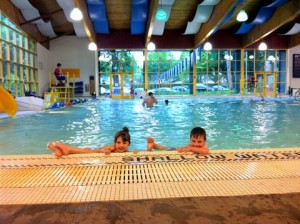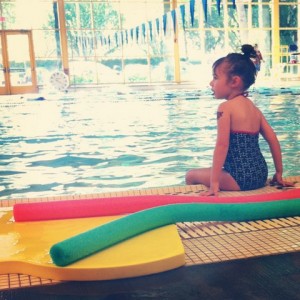

Babies are gestated in fluid. Some of them are born into water. It seems a natural state for them, yet their post-birth, aquatic experiences can cause us grownups plenty of anxiety. In the bath, we worry about the depth and temperature of the water, gentleness of care products, infants’ propensities to scream or poop during bath time, getting water in their eyes, and their general wiggly slipperiness. Even though we have years of life experience and education, the newest baby bath, and the rubber ducky thermometer, we still fret.
Time passes and we get more comfortable when babe meets H2O. Then, one day some social media thread, conversation with a friend, or the like gets us to thinking, “My kid is the only one I know not swimming on some level.” When we consider our wee ones’ first pool experiences, we contemplate chemicals (in the water and/or sunscreen), floatation devices, swim diapers, and the imminent dread of putting on our own bathing suits. My first post-partum swimming experience nearly gave me a heart attack and we never even got a toe in the water; it was just me and my freshly-suncreened four-month-old with a major bikini blowout in a hotel room equipped with a bitty sink and a standing-room-only shower. Two words: unmitigated disaster.
It turns out that our uneasiness is warranted as the CDC states that accidental drowning is the second-leading cause of death in children aged 1-4 years; that’s a heartbreaking statistic. But the good news is that whether you immediately register for a class or wait until next season, you can start thinking about water safety and encouraging the skills that will eventually help your babe to swim. Ultimately, swimming as a proficiency is essential; it comes not only with the potential to provide a life-time love of a fun, low-impact exercise, but it could also save your child’s life. Only you can decide what your child is ready for, but no matter where that is, you can get started.

What you need to know:
- The American Academy of Pediatrics (AAP) implores caregivers to be within an arm’s length of any child who is not a proficient swimmer in any depth or type of water. Accessories do not change this rule: bath seats, life jackets, or the like.
- The AAP warns against using air-filled flotation devices, despite their popularity, as they can easily deflate during use.
- Swimming lessons at any age do not drown-proof your child. Regardless of the ability of your swimmer, you should always pay close attention to kids in the pool, even when there is a lifeguard on-hand.
- No matter at what age your child starts lessons, studies show that their motor skills are generally not developed enough for real swimming until around age 5.5, though younger children do appear to benefit from what they learn.
- Open water (ocean, lake, and stream) is an entirely different ball game.
What you can do:
- Educate yourself on water safety, swimming, and other recommendations on AAP’s website: www.app.org.
- At home, continue to supervise all of your littles’ water time, teach them the dangers, and assess their comfort level. Encourage kids in the bath or your kiddie pool to practice holding their breath, pour water over their heads, put their faces in the water, and even back float. If you like cleaning your bathroom or you are outside, splash away.
- Open swims foster a comfort level with the sights and sounds of the pool and gives children an opportunity to experiment. For some, this might be playing on the steps; for others, it might be practicing jumping in or going down the slide to a waiting adult. Having fun and gaining confidence in the water is a beneficial stepping stone to formal lessons. Sprinklers and splash pads are also a great starting point.
- Swim lessons start at EVERY level. The youngest of us can join their grown-up in playing with water toys, sitting on big floating animals, and singing and “dancing” to songs. Group lessons with an instructor start at the non-swimming level. Confirm prerequisite skills with your chosen organization to maximize success. Once you get going, instructors will let you know your child’s progress. If group lessons aren’t your thing, consider private or semi-private lessons.
Where to go for lessons and/or leisure swimming:
- Portland Parks and Recreation
- YMCA
- McMenamins’ soaking pools
- Firstenburg Community Center
- North Clackamas Aquatic Park
- Farber Swim School
Personal tips:
- Some pools are considerably colder than others. The outside weather can also negatively impact the agreeability of a temperature-sensitive swimmer.
- Children over the age of 6 are typically not allowed in opposite-gender dressing rooms and not all pools have family changing rooms or access from the lobby, which could mean sending your child into a dressing room alone.
- Lessons for multiple kiddos at different levels may occur simultaneously; availability varies pool to pool, but this will save you time and sanity.
- Lessons multiple days a week may yield faster results, but the commitment is bigger than it seems.
- Consider lesson times that occur back-to-back with open or family swims for extra water time.
- Every pool’s marked depths are slightly different; start your time by walking the shallow end and defining (with visual markers) where your child’s feet safely touch.
Laura Jost is writer and hyper-careful mother, yet recently found herself retrieving her over-confident swimmer from the deep-end while fully clothed (shoes included). You can never be too aware, too careful, or have too much fun in the water!


